

Please verify you are a human
Access to this page has been denied because we believe you are using automation tools to browse the website.
This may happen as a result of the following:
- Javascript is disabled or blocked by an extension (ad blockers for example)
- Your browser does not support cookies
Please make sure that Javascript and cookies are enabled on your browser and that you are not blocking them from loading.
Reference ID: 9f0fea96-79a7-11ef-9121-72c412284990
Powered by PerimeterX , Inc.
- Skip to primary navigation
- Skip to main content
- Skip to primary sidebar
- Skip to footer
Yacht Cruising Lifestyle
Everything fun you can do from your yacht
Why You Need a Wind Vane for Your Sailboat
September 24, 2021 by Travis Turgeon 1 Comment
Many of today’s offshore cruising sailboats utilize a type of autopilot equipment called a windvane. A sailboat wind vane is a mechanical self-steering system that requires no electricity, fuel, or manpower to operate. It’s the perfect addition to bluewater cruisers and offshore sailboats. While a mechanical self-steering wind vane can’t hold you on a compass course, they’re more accurate than human steering over long distances. By reducing the overall mileage of a passage, you’re able to save time and money on your journey. Alternatively, a windvane is essential for short-handed or single-handed sailing. It gives the skipper a much-needed break from the helm when conditions allow.
How Does a Wind Vane Work on a Sailboat?
Mechanical wind vane systems are relatively simple in concept. Once mounted at the boat’s transom or somewhere along the stern, wind prompts the elevated vane to adjust the rudder or wheel steering system, putting your sailboat back on a wind-based course dictated by the captain. The idea is that you won’t have to make constant adjustments in variable winds. Automatic adjustments reduce boat heeling and allow your vessel to remain trim in the water.
In other words, wind vanes use wind and water resistance to return a ship to course when wind chages direction.
Sailboat Windvane Gears Vs. Electronic Autopilot Systems
Two primary self-steering systems are standard for bluewater cruisers and offshore sailboats: wind vane steering gears and electronic autopilot systems. Both systems have advantages, and many sailors choose to install both systems on their boats.
Electronic Autopilot Systems
Electronic autopilot systems are the modern answer to self-steering. They’re easy to use, work without wind, and are an excellent option for near-shore cruising and short-term offshore sailing. Autopilots are also compatible with multi-hull vessels, unlike windvane systems.
The downfalls to these systems can be daunting, though. Electronic systems are complex and have numerous parts: displays, wiring, plotters, motors – the list goes on. To run an electric autopilot system, you’ll also need a generator. Most even have two generators, using one as a backup for reliability. As you’d expect, they also come with a higher price tag.
Self-Steering Wind Vane Systems
Windvane steering systems take a more traditional approach to self-steering. They rely on the wind to operate your boat on the desired course. Wind vane steering systems require no electricity, little maintenance, have few moving parts. They also come in several variations to fit your boat in the best way possible. Another massive benefit of a mechanical sailboat windvane is its robust build. This allows reliable and powerful performance in heavy weather conditions.
There are also several downfalls to a windvane system. They do not work in the absence of wind or under power, can add weight and stress to the boat stern, can be initially expensive to purchase, and won’t work on multi-hull vessels.
Types of Sailboat Wind Vane Systems
All wind vane systems direct a boat to a wind-based course, but they each do it differently.
Servo-Pendulum Wind Vane
Servo-pendulum windvane systems are the most common commercially available system, and they are a favorite among most sailors. The reliability for offshore sailing is a huge selling point. It re-affirms why these are the “classic” wind-driven autopilot systems.
Main steering servo-pendulum systems have control lines running from the primary steering quadrant to a wheel or tiller. As the wind pushes the pendulum, it directs the boat’s steering by way of the primary rudder. Because of this, the system is solely dependent on the power of the wind. The stronger the wind blows, the more force the system provides to push the boat back on the desired course.
Rudder steering servo-pendulum systems have the pendulum rudder connected to the primary boat rudder. It works almost the same as the “main steering system,” with a few minor differences. The wind pushes the pendulum rudder to the side, forcing water to pull the boat’s main rudder to change steering. The advantage of this system over the prior is that it involves fewer mechanical components, making it easier to check issues and fix any problems. The disadvantage is that it can be a bit trickier to set.
One of the biggest downfalls of either servo-pendulum system is that the pendulum rudder can not replace an auxiliary rudder. Unlike an auxiliary rudder, its one-dimensional operation makes it unable to run the system if the primary rudder fails. These systems can also create a cluttered cockpit due to the lines running from the steering quadrant. Lastly, servo-pendulum systems generally require more consistent maintenance and more common repairs.
Auxiliary-Rudder Wind Vane
Unlike servo-pendulum steering systems, auxiliary-rudder wind vanes are entirely independent of all other aspects of the boat. Instead, the main rudder is locked, and the auxiliary rudder steers the vessel after setting a powerful windvane to the desired angle. The main rudder is often locked to the left of center or slightly at an angle to balance the helm. One of the most significant advantages to these systems is that if the primary boat rudder fails, the auxiliary rudder can act as a replacement to steer the boat.
There are some important considerations to make when purchasing auxiliary-rudder wind vane steering gear. First, auxiliary-rudder windvanes put a significant amount of stress on the vane, making it vital that the model and components are well designed and made of quality materials. If you can source well-made parts, there is minimal risk while out at sea. There are very few moving parts and no critical lines attached to the system. Second, these systems are big, heavy, and bulky. Having such a massive piece of equipment at the stern of the boat isn’t always ideal in every scenario. Lastly, auxiliary rudders can be awkward to operate when the mizzen is in use on ketch-rigged vessels.
Trim-Tab Wind Vane
Trim-tab windvanes are less common than they used to be after the emergence of the steering technologies listed above. The system works by attaching a “tab” to the main rudder. The small surface of the trim tab makes it easy for the wind to move it from side to side, which then forces water over the primary rudder in the opposite direction to keep the boat on course. Those with the appropriate skills and know-how can even construct a trim-tab themselves, although we recommend that they do not rely entirely on a self-made system.
The major drawback to trim-tabs is that the ability to fine-tune the system is somewhat limited in heavy conditions.
How to Install a Sailboat Wind Vane System
Installing a wind vane on your boat is relatively easy, but it still takes a bit of planning.
Initial Considerations
All windvane models require installation at the center of the boat’s transom or as close to the center as possible. Depending on which system you choose to run, you may need to account for the steering lines that operate the system. Steering lines are approximately a quarter of an inch in diameter and need a clear path from the wind vane to the boat wheel. You may redirect the lines with steering blocks, but be aware that each block adds friction and lessens the overall efficiency of the steering system.
Balancing the Boat
Windvane gears adjust the course of a boat using the wind force at the surface. For this to happen efficiently, you’ll first need to ensure your boat is balanced and sailing as intended. Take your time to get the weight distributed evenly. You’ll also need to reef the sails appropriately so as not to be overpowered.
Adjusting the System for the Conditions
Regardless of the system, nearly all sailboat wind vanes have one or more adjustment features so that you can optimize performance in various conditions. When wind conditions are relatively light, you should expose the vane as much as possible so that the system receives the most force as possible. In heavy winds, however, you can lower the windvane to reduce the impact on the system. In some cases, the wind vanes have sensitivity adjustments where the vane meets the pivot, so you may not need to adjust the height as weather conditions change.
How to Engage a Sailboat Wind Vane System
Most wind vanes are relatively adaptable and can adjust to fit a variety of hull types. Some vanes are even customizable to bolt directly onto the boat. As with any other object you bolt to your hull, plan to through-bolt everything with the appropriate bedding and backplates for maximum security.
Operating a sailboat wind vane is far less complicated than you might expect. There are four standard steps to engaging a windvane:
- Deploy the Gear : To do this, attach the wind paddle and unfold the rudder to be placed in the water. Doing this should only take a few minutes at most.
- Connect the Control Lines : Control lines run from the windvane to the boat wheel and may have steering blocks included in the setup. The system may require you to make a few knots or use some hardware, but again, it’s a relatively easy process once you’ve completed it once or twice.
- Balance the Boat and Set a Course : With the wind vane deployed, balance your boat, set the course to the desired point of sail, and adjust the windvane to engage the steering.
- Evaluate the Course and Adjust as Needed : Adjust the vane to steer more accurately after evaluating your approach. Course adjustments are made by rotating and trimming the paddle to match your course.
Perfectly balancing your boat is one of the easiest ways to make your self-steering wind vane more efficient in the water. A vessel with poor balance or trim will not just sail inefficiently, but it will put unneeded stress on the wind vane system.
Have more questions about sailboat windvane systems and how you can best implement them on your boat? Reach out to the #Boatlife community on our forum with questions or comments!
If you found this article helpful, please leave a comment below, share it on social media, and subscribe to our email list.
For direct questions and comments, shoot me an email at [email protected]
Sharing is caring!
Reader Interactions
June 12, 2022 at 5:44 pm
Thanks for the useful information. However, you didn’t mention anything about the usefulness of wind vanes in light or downwind sailing. You mentioned the issue of a mizzen and auxiliary rudder, how do I understand that (as we sail a ketch and thinking about installing a Hydrovane.
Leave a Reply Cancel reply
Your email address will not be published. Required fields are marked *
Save my name, email, and website in this browser for the next time I comment.
MB #20512 PO BOX 480 Sevenoaks Kent TN13 9JY
Tel: +44 56 0386 9163
Keep In Touch
Thank you for reading.
Join our online crew and find more about the #boatlife
Hebridean self-steering wind vane
“well worth investigating”
TOM CUNLIFFE The Complete Ocean Skipper
“I’m impressed… the vane performed well on all points of sail, including downwind… the servo pendulum system took control to the extent that it could sail a course with the sails badly set” DAVID PUGH Editor, Practical Boat Owner
Build your own servo-pendulum wind vane from a kit
The Hebridean wind vane is an innovative version of the tried and tested servo-pendulum self steering system for sailing boats steered by tiller or wheel. The Hebridean has crossed Atlantic and Pacific oceans but is also quick and easy to mount for weekend coastal sailing or jaunts across the Channel, Minch or other strait/sea.
Stern freeboard The kit fits yachts with stern freeboards from 600-1000mm (stationary). It is designed specifically for DIY construction. The Hebridean can be tilted up out of the water or lifted off the stern and stored on the guard wires. Or partially dismantled for storage below.
Horizontal vane axle The Hebridean is the only serv0-pendulum vane with an actual horizontal vane axle. One of its unique design features allowing boosted performance, simplified construction and enhanced efficiency in all conditions. John Fleming’s analytical genius was responsible for the innovative geometry on which this landmark development in servo-pendulum windvane design depends.
Simplicity For confidence at sea or in remote locations, the simplicity of its components and assembly crucially allows the unit to be maintained with tools usually found onboard. Building the Hebridean yourself is a hands-on “course” providing you not only with a good understanding of its workings, but also substantial confidence in your ability to maintain it anywhere.
Wood When sourcing your own wood you need 4m of suitable hardwood at 145 x 20mm (EU standard). The longest plank is 1800mm to make the pendulum/paddle for 1000mm height transoms. Here is the wood cutting plan .
Affordable The Hebridean offers DIY sailors the opportunity to build an affordable wind vane in wood and stainless steel, with no welding, bearings or plastic cogs in the main H2 Kit. (there is one worm and wheel in the optional Remote Course Adjustment Kit which can be viewed in action in this youtube video ). All the metal components are prefabricated (drilling and some surface finishing required) ready for you to bolt to the wooden frame. The build requires basic wood-work skills and tools. And several days of absorbing and highly rewarding work.
Wheel steering too A “drum” kit for connecting the Hebridean to wheel steering is available.
Shipping For shipping costs, please contact me at the email address below with your full name, delivery address and phone number (required by carrier) for a quotation.
Kit prices Prices are listed on our Prices & Ordering page.
A section by section video from Hebridean builder, Ian French Thank you Ian!
- Part 1 Intro and frame: Intro & Frame
- Part 2 Turret and Vane : Turret & Vane
- Part 3 Fixtures and fittings : Fixtures & Fittings
- Part 4 Servo Rudder: Servo Rudder
- Part 5 Boat mounting: Boat Mounting
- Part 6 Testing the wind vane: Testing the Wind Vane
- Part 7 Wind vane in action
- Part 8 See the remote steering mechanism being assembled . The single weld required in Part 8 is completed by us before kit dispatch.
- Part 9 Preparing Remote Control Lines
See the Hebridean in action
- Videos shot in Scotland in varying sea and wind conditions Scotland Sea Trials
- Trials over 8 years of coastal and off-shore sailing by John Fleming, the designer of the Hebridean Wind Vane The Hebridean in action.
- Emmanuel sailing on Lake Geneva with Mont Blanc in the background Wind Vane in action on Lake Geneva
- Mounted on the 45 degree rudder stock of a Twister off the Scilly Isles https://www.youtube.com/watch?v=FNlZHFFseB0
- Finnish archipelago Sailing https://photos.app.goo.gl/hYWTEcJhbdX3WGe39
- Wheel steering , all beautifully finished, on Al Hanson’s Pearson 31-2. Al’s video also features his removable Hebridean mounting solution attached to his folding transom boarding ladder.
- 1912 Falmouth Quay Punt Plymouth https://www.youtube.com/watch?v=n6BIxYQUPiM
- Wind vane and dolphins off Fair Isle https://vimeo.com/136486631
- Courtesy Tom Fisher on “Angus” The Hebridean Wind Vane in action in strong winds 25/5/17 Bermuda to Azores https://www.youtube.com/watch?v=Po-oXzVaIAk
- Kristian Møller Pedersen’s first day out with the Hebridean on trial after having completing the wind vane also see testimonials page https://youtu.be/d2fjzbkh0dU
- https://www.youtube.com/watch?v=Yg7JgwH6Y58
- https://youtu.be/1090Z-dK2Ys
- https://www.youtube.com/watch?v=EjAUfm-i6Yw
- Hebridean mounted on top of rudder stock on a canoe stern sailing off Canary Islands Hebridean in use in Canary Islands
- An afternoon sail in 10 to 15 knots on Port Phillip Bay watch-v=QBx0ywAjMCA&feature=youtu.be
- Video of the “drum” kit watch-v=4KLWJbYYOF0&feature=youtu.be
Frequently Asked Questions

John Fleming 1951 – 2023 teacher yachtsman inventor thinker
Here is a 10 minute video tribute to the Hebridean’s designer, John Fleming. It was aired at his life celebration in The Tip i at his family home, The Dell, Nethy Bridge, 19 April 2023. https://www.sgmarkphotography.com/Client-Area/John-Fleming Use password sleepyeagle (the name of John’s Pioneer 10).
Notice from Ian Kirkwood
When John’s health got worse, he asked me again to take on the project. I am an enthusiastic fan of his highly ingenious version of the servo-pendulum self steering-system. I sailed in company with John on and off for a decade — using my own Hebridean (I was his first customer in 2013).
Our Hebrideans steered us around Scotland’s northwest coast and isles. We made three trips in company to the Faroe Islands. On the first of these I sailed happily solo. All thanks to the Hebridean. Dying winds foiled an attempt to reach Iceland: our boats lay calmly hove-to overnight a few miles off the Butt of Lewis. Plan B proved to be a fabulous voyage down the length of the Atlantic coast of the Outer Hebrides. A highlight was anchoring off Callanish in blazing sun.
I hope to continue John’s personal style of service. Please allow a generous lead time as I get used to stocking the components and preparing Hebridean kits while maintaining their high quality…and a reasonable kit price in times of rising costs.
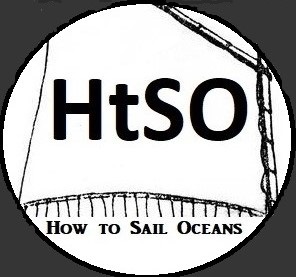
Kevin Boothby Sailing
Build Your Own Self-Steering Windvane
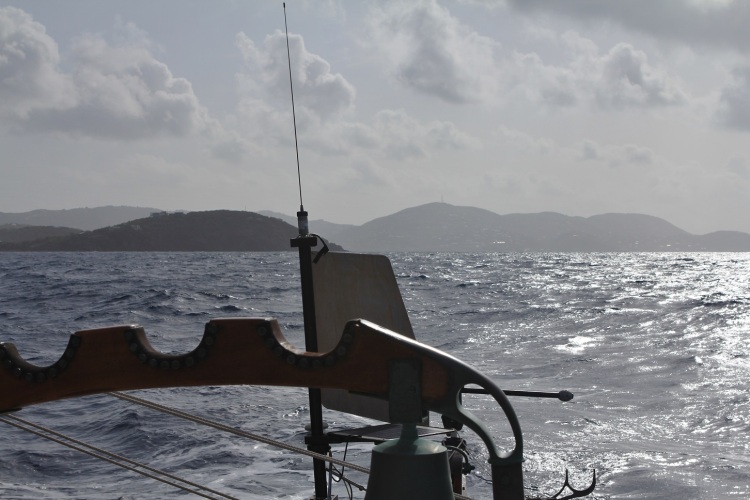
For the short-handed sailor planning long ocean crossings, a self-steering windvane is not essential but darn close to it. For boats with stern-hung rudders, a self-steering windvane can be constructed with readily available materials and a modest level of skill.
It’s all about leverage. There will be an air paddle which will weathercock to the wind and provide enough torque to move the trim tab which we are going to mount on the trailing edge of the rudder. The trim tab will be a slender, high aspect ratio blade, and we will add some “balance” to it–a little bit of the blade will lead the shaft–all so as to lessen the torque required to move the trim tab when the water is flowing over it and thus increase the amount of leverage the air paddle has over it.
Let’s start with building the trim tab. The trim tab should be somewhere around 10 to 15 percent of the area of the rudder. We decide on the correct diameter of shaft for the blade. In my case this was a 5/8″ diameter stainless steel shaft. We then drill several (say four) holes to take through-bolts which will hold the wooden blade to the shaft. Below is the rough blade held to the shaft with 1/4-20 bolts. Notice the thinner piece on the leading edge, this will give it some balance.
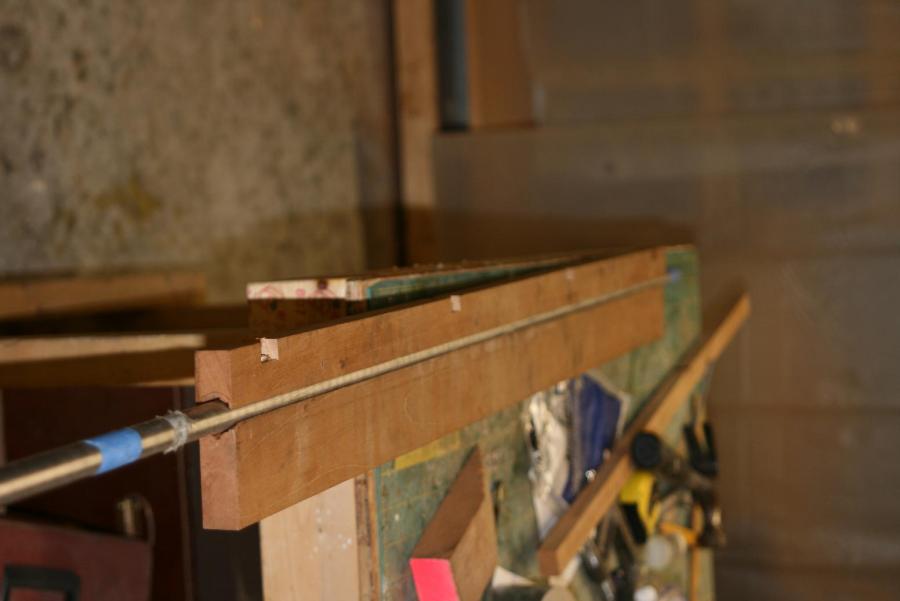
We then permanently attach the blade with the bolts and 3M 5200 and begin fairing:
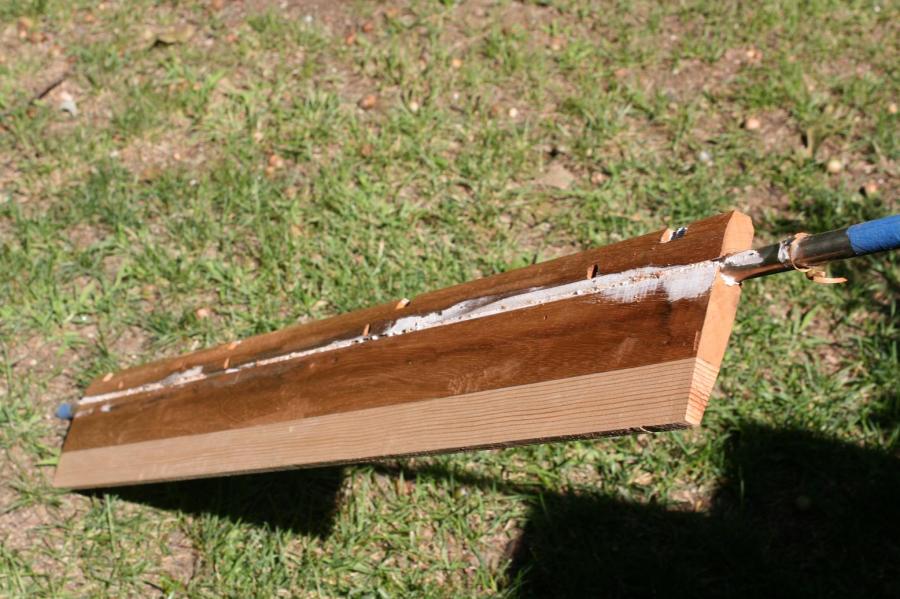
Following fairing and shaping we will then encase the entire blade in fiberglass roving and epoxy, this will add a great deal of strength and durability.
Now we have to mount it on the end of the rudder. But before we start drilling any holes, we need to work out some geometry. The trim tab must be mounted such that the air paddle will attach at the “no action point”; that is, where the trim tab shaft intersects the axis of rotation of the rudder. This is important because if the air paddle is not attached at this point, the turning of the rudder will wag the air paddle back and forth resulting in poor performance. Hopefully the diagram below will make this clear:
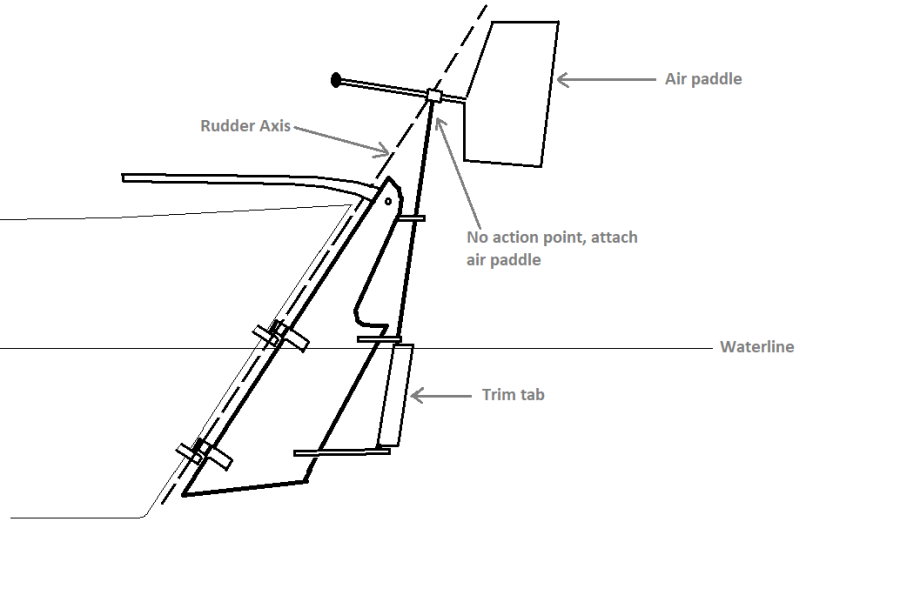
For the gudgeons on the rudder I used 1″ thick pieces of ash which I cut like opened jaws to slide onto the trailing edge of the rudder. They were finally attached with through-bolts and plenty of 3M 5200. For the bottom gudgeon I drilled a slightly oversized hole for the shaft to drop down through. On the inside of the hole I put a few laminates of epoxy and fiberglass roving to minimize friction and make it snug (note: I’ve since inserted a nylon bushing, which works better).
Similarly for the upper gudgeon EXCEPT that I opened the hole to the outboard end so that it formed a “U” and then closed it with a small U-shaped piece of plywood bolted on top and facing inboard (see pics below). Why? So that the trim tab can be removed for servicing.
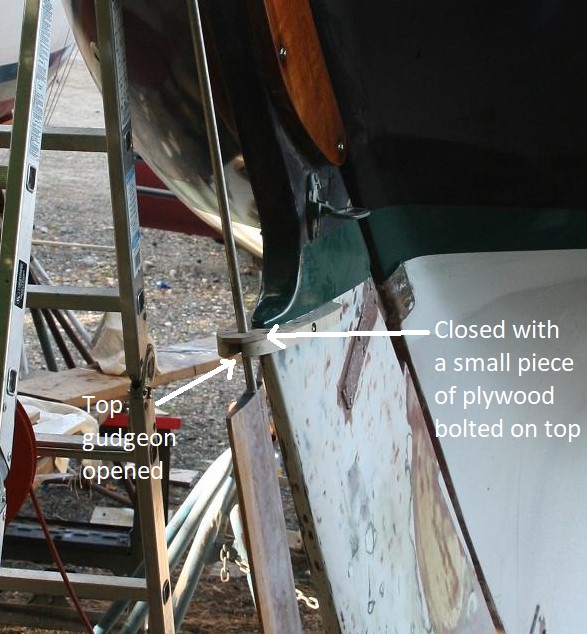
And finally there is a third gudgeon at the rudder head, which is simply screwed onto a wooden cleat mounted there, again so that it can be easily removed.
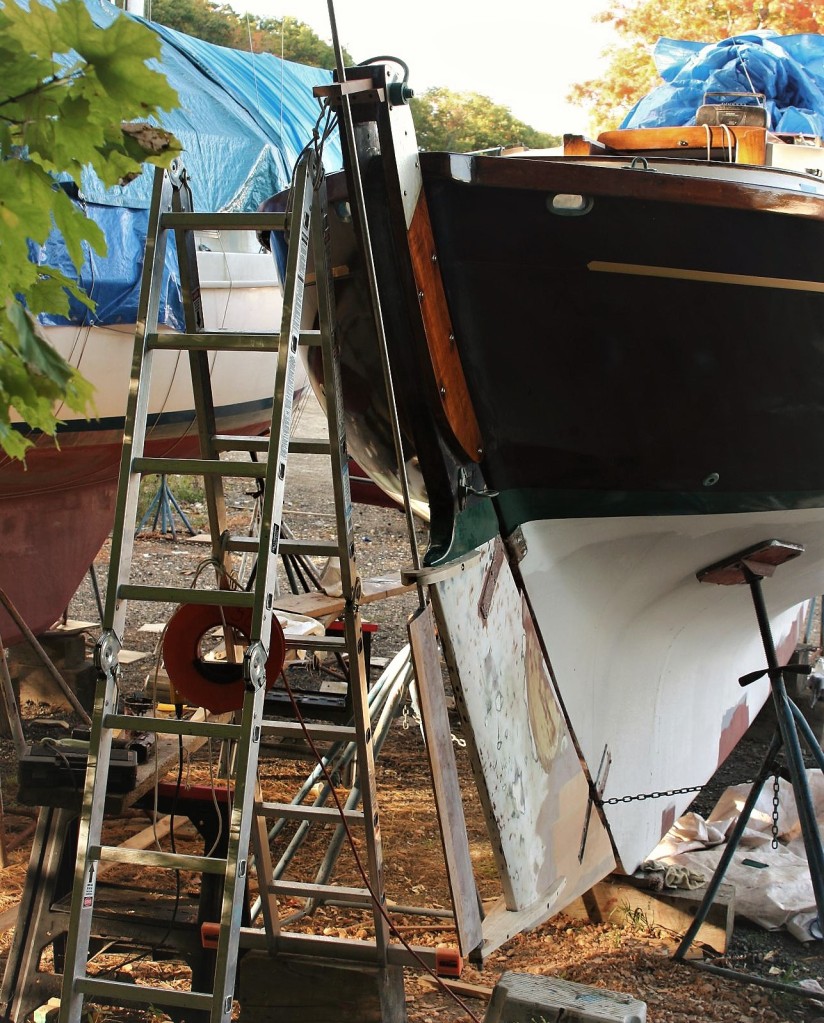
Now we have come to the issue of attaching the air paddle. First of all, the air paddle needs to be balanced. This means the axis where the trim tab shaft runs through it is also the center of mass, or if the shaft was held horizontally and the air paddle free to rotate it would not choose to do so absent any wind. Since the plywood air paddle has weight, this will require a counterweight for which I used a regular shaft zinc clamped to a wooden dowel.
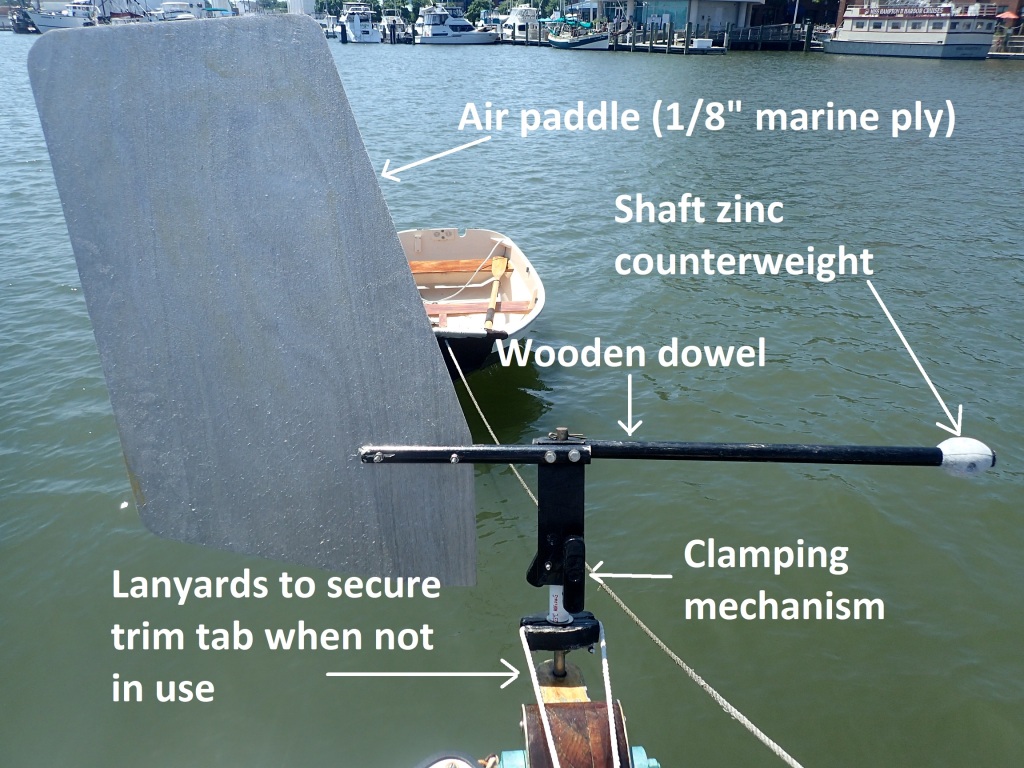
With our air paddle and counterweight constructed the last remaining item is the engaging mechanism. I opted for the simplest possible, simply boring a hole up a rectangular piece of timber for the shaft to pass through, and then sawing about halfway up from the bottom (see above photo). The air paddle and counterweight are bolted at the top, while at the bottom, on either side of the bored shaft hole, are 1/4-20 bolts with big handles on them. The opposing nuts are set in epoxy. Thus the air paddle can freely turn on the shaft until I tighten the bolts, when it clamps onto the shaft and the windvane is thus engaged.
And that’s it. So far this vane has steered me over 30,000 miles. I can get it to work in winds down in the 3-6 knot range, and then it has steered the boat while running before a gale under bare poles. In order to work well in light airs the gudgeons must be greased from time to time. This can easily be accomplished in the water while donning a mask and snorkle. Just lift the trim tab up a few inches (it cannot actually pop out of the bottom gudgeon before the blade runs up against the upper gudgeon–with the little plywood cap on, of course), clean, grease, and set back down.
Now one peccadillo I have found with this type of steering vane is the tendency to over-steer. It tends to shove the helm too fast and too far on either side, causing the boat to sail a slalom course. One cure for this is to attach shock cords to your tiller lashings which will greatly dampen the effect. The size and setup of the shock cords will vary from boat to boat. Here is my current setup shown below:
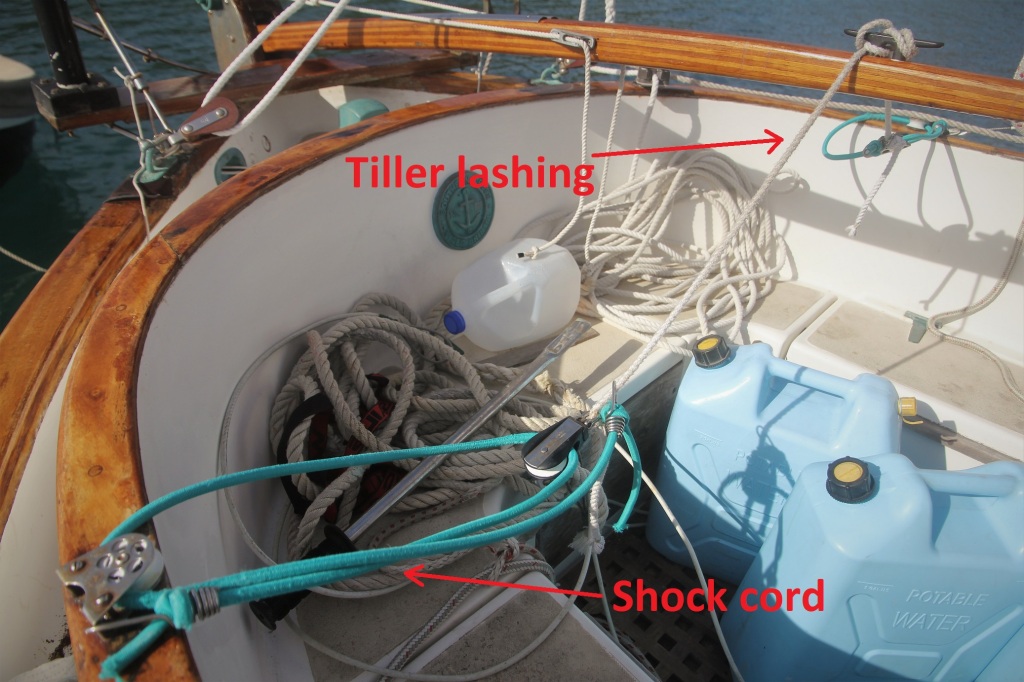

Latest Posts
Conquer nature, kill god.
Our long and difficult relationship with nature needs to be understood in a first hand way. Sunshine State Politics January, 2024 Thus far my sailing sojourn to Florida and the Keys has been spectacular. I’m not merely talking about the weather, which of course comes as a welcome change from November in New England. The…
First my story (sorry to bore you) The solitary reader supplies his own assessment of his relationship to those he meets in print. This can result in some unpleasant reckonings with reality, yet by the same token, the lover of literature may become confident enough about everything he has worked out in his mind as…
The Quota Women of the Ocean Race
Diversity, Equity, and Inclusion is now queen of the seas “I Wasn’t a Quota” Margaret Thatcher famously bristled at the suggestion that her rise to power and ability to rule had anything to do with her sex. In a 1993 interview with NPR she is quoted as saying: “Well, I would like (the assessment of)…
“The Future is Female” Has Us All Going Broke
Modern feminized women are taught that men are either tyrants or incompetent boobs, so it’s better to rely on the government, as the government has the power to coerce men to hand over their money and to punish them for unacceptable behavior. Part I: The Assemblywomen I regard it as a matter of course that…
Something went wrong. Please refresh the page and/or try again.
Share this:

- Already have a WordPress.com account? Log in now.
- Subscribe Subscribed
- Copy shortlink
- Report this content
- View post in Reader
- Manage subscriptions
- Collapse this bar

Wind Vane Self Steering: The Ultimate Guide
by Emma Sullivan | Jul 20, 2023 | Sailboat Gear and Equipment

Short answer: wind vane self steering
Wind vane self steering is a mechanical device used on sailboats to maintain a desired course without the need for continuous manual adjustment. It utilizes the force of the wind and a vertical axis to steer the boat by adjusting the position of the rudder.
How Wind Vane Self Steering Works: A Comprehensive Guide
Title: How Wind Vane Self-Steering Works: A Comprehensive Guide to Sailboat Autonomy
Introduction: Sailing is the epitome of freedom, embracing the unpredictable elements as we navigate vast oceans. However, when embarking on long journeys or overnight trips, the need for reliable self-steering systems arises. Enter wind vane self-steering! In this comprehensive guide, we will delve into this ingenious system, explaining its principles and mechanics while highlighting its benefits for seafaring enthusiasts. So hoist your sails and embark on a journey of knowledge as we unravel the inner workings of wind vane self-steering.
Chapter 1: The Basics of Wind Vane Self-Steering 1.1 Understanding Sailboats’ Balancing Act: – Explaining the importance of maintaining equilibrium between the sail and rudder configurations. – Highlighting challenges faced when manually helming during long passages.
1.2 Introduction to Wind Vanes: – Defining the wind vane as an autonomous steering mechanism driven by apparent wind direction. – Detailing their various components such as vanes, sensors, gears, and linkages.
Chapter 2: Principles Behind Wind Vanes 2.1 Apparent vs True Wind: – Unveiling the distinction between apparent and true wind direction. – Describing how wind vanes utilize apparent wind to adjust course.
2.2 Weight vs Force Systems: – Distinguishing weight-driven systems (servo pendulum) from force-driven ones (auxiliary rudder). – Discussing pros and cons of each system in different sailing conditions.
Chapter 3: Mechanics of Wind Vane Self-Steering 3.1 Servo Pendulum System: – Unveiling the engineering marvels behind servo pendulum systems. – Analyzing their interaction with changing winds and seas.
3.2 Auxiliary Rudder Systems: – Detailing the mechanism of auxiliary rudder systems, their hydrodynamics, and adjustability. – Discussing how they maintain sailboat course while minimizing yaw.
Chapter 4: Installation and Utilization Tips 4.1 Installing Wind Vanes on Different Sailboats: – Providing step-by-step instructions for mounting wind vanes. – Highlighting considerations for various boat designs and sizes.
4.2 Calibration and Fine-Tuning: – Elaborating on the importance of accurate calibration to ensure precise steering. – Offering pro tips to optimize performance under different sailing conditions.
Chapter 5: Advantages and Limitations 5.1 Benefits of Wind Vane Self-Steering: – Presenting the advantages of autonomy, reduced energy consumption, and enhanced safety during long-haul sailing trips.
5.2 Considerations in Complex Sailing Conditions: – Identifying limitations related to challenging weather patterns or narrow channels, necessitating manual intervention.
Conclusion – Navigating the Open Seas with Confidence: Wind vane self-steering systems revolutionize long-distance sailing by providing sailors with a reliable automated alternative to constant helming. Understanding the principles, mechanics, and installation tips outlined in this comprehensive guide will empower seafarers to navigate vast oceans with confidence, leaving them more time to revel in the beauty of their surroundings. Embrace the freedom that wind vane self-steering offers–the transformative companion for every true sailor!
Wind Vane Self Steering Explained: Step by Step Process
When it comes to sailing, one of the most essential tools for achieving steady and reliable course keeping is a wind vane self-steering system. This mechanism harnesses the power of the wind to effectively steer the vessel autonomously, ensuring sailors can enjoy a smoother and more hands-free sailing experience. In this blog post, we will delve into the step-by-step process of how wind vane self-steering works, unraveling its inner workings and highlighting its benefits.
Step 1: Understanding the Basics
Before we dive into the intricacies, let’s start with the fundamentals. A wind vane self-steering system consists of three main components: a wind vane, a linkage mechanism, and auxiliary steering gear. The wind vane acts as a sensory organ that detects changes in wind direction while transmitting these signals to the linkage mechanism. The linkage mechanism then translates those signals into appropriate movements, which are eventually transmitted to auxiliary steering gear responsible for adjusting sail trim or rudder angle.
Step 2: Wind Vane Sensitivity Adjustment
Once you’ve set up your wind vane self-steering system on board your yacht or sailboat, it’s crucial to fine-tune its sensitivity for optimal performance. By adjusting the weight distribution or adding counterweights to your wind vane, you can achieve precise responsiveness according to prevailing weather conditions. This careful calibration ensures that even subtle nuances in wind direction are accurately detected by the wind vane.
Step 3: Setting Course
Now that your system is finely tuned, it’s time to set your desired course manually using traditional methods such as compass bearings or GPS coordinates. Aligning your vessel towards this designated course provides initial guidance for your wind vane self-steerer.
Step 4: Autonomy Engaged
As soon as you activate your wind vane self-steering gear, you enable an autonomous sailor’s best friend. Once the wind vane starts detecting any deviations from your initial course, it sends signals to the linkage mechanism, instructing it to make corrections. This process ensures that your vessel automatically adjusts its heading to maintain the desired course against external factors such as wind shifts or gusts.
Step 5: Continuous Monitoring
While wind vane self-steering handles most course corrections independently, it does require regular monitoring to avoid any potential issues and make minor adjustments as needed. It is crucial to stay vigilant and keep an eye on how your self-steering system performs with changing wind conditions and other environmental factors.
Benefits of Wind Vane Self-Steering
Now that we’ve dived into the step-by-step process of wind vane self-steering, let’s explore its advantages:
1. Hands-free Sailing: With a properly calibrated and functioning wind vane self-steering system, sailors can free themselves from continuously holding the helm, affording a more relaxed sailing experience.
2. Increased Safety: Wind vane self-steering reduces fatigue in long ocean crossings by maintaining a steady course, minimizing human error risk at times when crew members might be physically exhausted.
3. Energy Efficiency: By utilizing the power of nature (the wind), a wind vane self-steerer requires no fuel consumption or electricity input for operation, making it an environmentally friendly and cost-effective solution for long-distance voyages.
In conclusion, the step-by-step process behind a wind vane self-steering system involves understanding the basics of its components, adjusting sensitivity levels, setting an initial course manually while enabling autonomy through continuous monitoring. This technology not only enhances safety but also allows sailors to enjoy hands-free sailing while embracing Mother Nature’s forces to keep their vessels on track efficiently. So why not embrace this clever innovation and sail away into effortless adventure?
Frequently Asked Questions about Wind Vane Self Steering
Frequently Asked Questions about Wind Vane Self Steering: Unlocking the Secrets to Effortless Sailing
If you’ve ever been on a sailing adventure or have spent any time around seasoned sailors, you’ve likely heard of wind vane self steering devices. These ingenious contraptions have sparked curiosity and interest among many sailing enthusiasts, but like any new concept, questions tend to arise. In this blog post, we will dive deep into the frequently asked questions surrounding wind vane self steering systems and shed light on their working principles. Get ready to unravel the science behind these mechanical marvels!
Q1: What exactly is a wind vane self-steering system?
A wind vane self-steering system is a mechanism designed to keep a sailing vessel on course without manual intervention from the helmsman. This device utilizes the power of the wind to maintain a steady heading even in challenging weather conditions. By harnessing wind pressure and utilizing specially shaped vanes, wind vane self-steering systems elegantly counterbalance forces acting on sails and rudders.
Q2: How does a wind vane self-steering system work?
The operation of a wind vane self-steering system revolves around one fundamental principle—using apparent wind angles and force to steer the boat. Typically mounted at the stern of a vessel, these systems consist of an arrow-shaped vane that reacts to changes in apparent wind direction. As the breeze shifts or fluctuates in intensity, subtle movements in the vane are transmitted via lines or linkage mechanisms to adjust the position of an auxiliary rudder at the boat’s stern.
When the boat begins deviating from its intended course due to shifting winds, turbulence, or waves, this auxiliary rudder automatically adjusts itself according to variations in apparent wind angles detected by the main vane. Consequently, as long as there is sufficient breeze available for propulsion, these systems effectively maintain precise navigation even during extended periods at sea. It’s like having an invisible helmsman tirelessly steering your vessel, allowing you to relax and enjoy the journey.
Q3: Are wind vane self-steering systems compatible with all types of boats?
Wind vane self-steering systems are highly versatile and can be installed on a wide range of sailboats. Whether you have a small, single-handed cruiser or a larger ocean-going yacht, there is likely a system that suits your vessel. The main considerations when choosing the right wind vane self-steering system for your boat include size, weight, balance, and how well it integrates with the existing rigging setup. Manufacturers provide detailed guidelines and support to ensure compatibility with various boat designs.
Q4: Can wind vane self-steering systems handle different weather conditions?
Absolutely! Wind vane self-steering systems are designed to thrive in diverse weather conditions and adapt to changing environments. Whether you’re facing calm seas or rough waters with strong winds, these remarkable devices remain stable and steadfast in their coursekeeping abilities. However, it is essential to learn about any limitations specific to the model you choose based on sailing experience and intended use.
Q5: Are wind vane self-steering systems difficult to install?
While installing a wind vane self-steering system may require some technical know-how, most reputable manufacturers provide comprehensive manuals and guidance materials tailored for DIY installations. However, if you prefer professional assistance or lack the confidence in setting it up yourself, seeking help from expert marine technicians is always an option worth considering.
In conclusion, wind vane self-steering systems offer sailors an unprecedented level of autonomy on their voyages by effortlessly maintaining course while they sit back and take in the panoramic beauty around them. Their ingenious working principles elegantly leverage wind power to navigate through uncharted waters. Embracing one of these marvels on your own sailing adventure might just be the key to unlocking new levels of sailing satisfaction. So, batten down the hatches, set your sails, and let the wind vane self-steering system be your faithful navigator on this extraordinary journey!
Mastering the Art of Wind Vane Self Steering: Tips and Techniques
For sailors navigating the vast blue oceans, wind vane self-steering systems are an invaluable tool. These impressive devices not only alleviate the stress of manual helm control but also empower sailors to sail solo or in small crews with ease. However, mastering the art of wind vane self-steering requires more than just installing the equipment – it demands practice, knowledge, and a cunning understanding of its intricacies. In this blog post, we will delve into the depths of wind vane self-steering, providing you with tips and techniques that will have you sailing like a seasoned pro.
Understanding the Basics:
To begin our journey towards mastering wind vane self-steering, let’s start by unraveling its fundamentals. A wind vane self-steering system essentially functions based on an aerodynamic principle: it utilizes changing winds to adjust your boat’s course automatically. The device consists of a wind vane mounted atop your vessel’s stern along with various lines and connections to your ship’s wheel or tiller.
1. Sail Trim is Key:
Properly adjusting your sails plays a crucial role in maximizing the efficiency of your wind vane self-steering system. Ideally, before engaging the device, ensure that your sails are appropriately trimmed for optimal performance based on existing weather conditions. Fine-tuning this aspect will allow for smoother operation and minimize any unnecessary strain on both boat and gear.
2. Get Acquainted with Your System:
Understanding how every component in your wind vane self-steering system works is vital for seamless operation. Familiarize yourself with all cables, lines, blocks, attaching points, and mechanical adjustments within your setup through careful study of instructions provided by manufacturers. Additionally, consider practicing installation and removal procedures before setting sail to save time during maintenance or repairs at sea.
3. Devise Efficient Linkages:
Connecting your wind vane to the ship’s wheel or tiller requires creating a linkage mechanism that transmits the vane’s signals accurately. Carefully select and adjust mechanical linkages, ensuring that they offer proper responsiveness and minimal play. Remember, any slack in these connections will decrease accuracy and compromise performance.
4. Experiment with Tension:
Fine-tuning the tension on your wind vane’s lines is essential for achieving optimal response. Experiment by adjusting the tension – both tightness and looseness – of these lines based on prevailing conditions such as wave heights, wind strength, course changes, or boat speeds. This flexibility allows you to adapt your wind vane self-steering system according to real-time situations and enhance its efficiency.
5. Observe Nature’s Cues:
Nature can be an exceptional teacher when it comes to utilizing wind vane self-steering systems effectively. Observing how wind shifts affect your vessel’s course during different weather patterns will help you develop a keen sense of understanding impending changes in wind direction. By balancing this observation with data from meteorological sources or barometers, you can anticipate shifts ahead of time, allowing for precise adjustments even before they happen.
6. Make Incremental Adjustments:
Once your wind vane self-steering system is activated, it is essential not to make abrupt adjustments unless absolutely necessary. Instead, opt for small incremental changes when altering course or sail trim. Gradual adaptations ensure smoother transitions without overwhelming the device with sudden demands.
7. Continuously Monitor Performance:
Constant vigilance is key while learning to master your wind vane self-steering system completely. Continuously monitor its performance by observing your boat’s behavior relative to sea conditions (weather helm, leeway). Appropriate awareness combined with timely tweaks ensures efficient operation throughout extended voyages.
8. Seek Expert Advice:
When seeking mastery over any subject matter, there is no substitute for expertise gained through experience and shared wisdom. Engage with sailing communities, forums, or seek advice from seasoned sailors who have honed their skills in wind vane self-steering. Their firsthand experiences and clever tricks will provide invaluable insights to propel your learning curve forward.
In conclusion, mastering the art of wind vane self-steering is a journey that requires practice, experimentation, and understanding. By grasping the basics, fine-tuning sail trim, learning your system inside-out, observing nature’s cues, and making incremental adjustments while monitoring performance attentively, you can unlock the true potential of this remarkable piece of sailing technology. So hoist your sails high and let the wind vane guide you towards a new realm of solo or small crew sailing prowess!
Choosing the Right Wind Vane Self Steering System for Your Boat
When it comes to sailing, there’s nothing quite like the feeling of gliding through the open waters, with the wind in your hair and the sun on your face. However, navigating a boat can be a challenging task, especially when you’re all alone out on the vast ocean. That’s where wind vane self steering systems come into play.
A wind vane self steering system is an invaluable piece of equipment that allows sailors to maintain course without having to constantly adjust their sails or helm. This automated system harnesses the power of the wind to steer the boat, freeing up valuable time and energy for sailors to focus on other important tasks.
But with so many different options available on the market, how do you choose the right wind vane self-steering system for your boat? Here are some key factors to consider:
1. Boat Size and Weight: The first thing you need to take into account is the size and weight of your boat. Wind vane self-steering systems come in various sizes designed to accommodate different vessels. It’s important to choose a system that is specifically built for boats within your size range to ensure optimal performance and stability.
2. Ease of Installation: As a sailor, you want a wind vane self-steering system that can be easily installed without requiring extensive modifications or additional support structures. Look for systems that come with clear installation instructions and minimal hardware requirements.
3. Weather Conditions: Sailors know that weather conditions can change rapidly at sea. Therefore, it’s essential to select a wind vane self-steering system that can handle a wide range of weather conditions – from light breezes to heavy winds and high seas. Look for systems that are durable and capable of maintaining control even in challenging weather scenarios.
4. Sensitivity Adjustment: Every boat handles differently based on its design and load distribution. To ensure precise control, choose a wind vane self-steering system that allows you to adjust its sensitivity to match your boat’s characteristics. This flexibility will enable you to fine-tune the system for optimal performance and responsiveness.
5. Reliability and Durability: When you’re out on the open water, you rely heavily on your equipment. Therefore, selecting a wind vane self-steering system from reputable manufacturers known for their reliability and durability is crucial. Look for systems made from high-quality materials that can withstand the harsh marine environment for years to come.
6. Cost: While cost should never be the sole determining factor, it’s still an important consideration when choosing a wind vane self-steering system for your boat. Evaluate different options and compare their features, performance, and price tags to find the best value for your money.
Now, armed with these essential considerations, you can embark on finding the perfect wind vane self-steering system that suits your boat and sailing needs. Remember to carefully research different products and consult with fellow sailors or experts if needed. With the right wind vane self-steering system onboard your boat, you’ll experience smoother sailing adventures like never before!
Troubleshooting Common Issues with Wind Vane Self Steering
Introduction:
Wind vane self-steering systems are a remarkable solution for sailors aiming to harness the power of the wind to navigate their vessels. By allowing the wind to guide the boat’s rudder, these systems reduce manual effort and provide a more reliable means of steering. However, like any piece of equipment, wind vane self-steering systems can sometimes encounter common issues that require troubleshooting. In this blog post, we will delve into some possible problems and provide professional, witty, and clever explanations on how to overcome them.
1. Lack of responsiveness: One frustrating issue that sailors may encounter with wind vane self-steering is a lack of responsiveness. If your system seems sluggish or fails to react promptly to changes in the wind direction, there are a few potential causes.
Explanation: Just like us humans after an indulgent Thanksgiving dinner, wind vanes can become lethargic too! The most common culprit for unresponsiveness is excessive friction within the system caused by wear or improper lubrication. To tackle this issue, start by giving your system a good inspection. Look for any signs of wear on bearings and joints while applying lubrication generously where needed (Think spa day for your wind vane). If this fails to resolve the problem, it might be worth checking if any foreign objects or debris have made their way into critical components – just imagine trying to navigate gingerly during peak pollen season!
2. Oscillations and instability: Unwanted oscillations or instability in your self-steering system can make sailing feel like riding a bucking bronco! This issue can be concerning and potentially dangerous if left unresolved.
Explanation: Imagine you are attempting to steer straight but your trusty wind vane has gained an affinity for dancing instead – quite embarrassing! The primary reason behind oscillations and instability is often an imbalance between sensitivity settings and sail trim (imagine mismatched dance partners). Adjusting both variables can help find the sweet spot. Additionally, thicker or heavier sails may contribute to excessive oscillations, so it might be time to reassess your sail wardrobe and consider adopting a lighter ensemble for smoother sailing (we all deserve a wardrobe makeover now and then!).
3. Misalignment and wandering: Has your wind vane suddenly decided to become an explorer, sailing in any direction other than the one you intended? Misalignment and wandering can occur due to various factors.
Explanation: Picture this – you want your wind vane pointing north, but instead, it decides it wants to discover hidden treasures in the opposite direction – quite the rebellious spirit! Misalignment is commonly caused by incorrect installation or loose connections between the wind vane and the boat’s rudder. Ensure that all parts are securely fastened with the precision of a complicated jigsaw puzzle (but without the frustration). When resolving misalignment issues, imagine you are showing your wind vane some tough love – tighten those nuts and bolts until they can’t even think about misbehaving!
Conclusion: While wind vane self-steering systems generally offer efficient steering solutions for sailors, encountering common issues is not uncommon. By understanding these challenges and implementing our witty troubleshooting advice, your wind vane will be back in shape in no time. Remember, a witty approach combined with professional expertise ensures smooth sailing both on water and through blog posts!
Recent Posts

- Sailboat Gear and Equipment
- Sailboat Lifestyle
- Sailboat Maintenance
- Sailboat Racing
- Sailboat Tips and Tricks
- Sailboat Types
- Sailing Adventures
- Sailing Destinations
- Sailing Safety
- Sailing Techniques
- --> Login or Sign Up
- Login or Sign Up -->
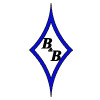
- B&B Annual Messabout
- Capsize Camp
- All Kayaks and Canoes
- Diva 15'8" Kayak
- Grand Diva 17'6" Kayak
- Moccasin 12' Canoe
- Flyfisher 13' Canoe
- Moccasin 14' Canoe
- Moccasin Double 15'6" Canoe
- Birder Decked Canoe 13' and 15'8
- Expedition Sailing Canoe
- All Dinghies and Tenders
- Catspaw Pram
- Spindrift Dinghy
- All Sailboats
- Core Sound 15
- Core Sound 17
- Core Sound 17 Mark 3
- Core Sound 20
- Core Sound 20 Mark 3
- Bay River Skiff 17
- Belhaven 19
- Mini Trimaran
- Class Globe 5.80 Kit
- Princess Sharpie 22'
- Princess Sharpie 26'
- All Powerboats
- All Jessy Skiffs 12-17'
- Jessy 12'
- Jessy 15'
- Jessy 17'
- All Outer Banks Cruisers
- Outer Banks 20
- Outer Banks 24
- Outer Banks 26
- All Ocracoke Center Consoles
- Ocracoke 20
- Ocracoke 20-B
- Ocracoke 24
- Ocracoke 256
- Cape Lookout 28
- Wing Foil Kits
- All Other Kits and Plans
- "Tractor" Canoe Seat
- Mast Head Floats
Windvane Self Steering
- All Building Supplies and Tools
- Marine Plywood
- All B&B Epoxy
- Temperature Control for Epoxy
- Epoxy Additives
- All Hardware and Rigging
- All Rigging
- Eyestraps and Fairleads
- Shackles, Hooks and Pins
- All Rudder Hardware
- Pintles and Gudgeons
- Tillers and Accessories
- Hardware kits
- All Masts, Track and More
- 6061-T6 Aluminum Tubing
- Sailtrack and Accessories
- Starboard Mast Plugs
- Wind indicators
- All Electrical
- Battery Monitors
- Solar Power System
- Boarding Ladders
- Beach Rollers
- All Apparel
- B&B Approved Products and Tools
Shop by Brand
B&b yacht designs.
- Amarine Made
- Armstrong Nautical
- View all Brands
Shop by Category
- Rudder Hardware
- Other Kits and Plans
The purpose of a wind-vane self steering device is to allow the skipper to do something other than sitting at the helm. While this is not practical for most un-ballasted small sailboats, a self steering device is an essential tool for the cruising sailor. Graham has been testing the wind vane on his Core Sound 17 Mark 3 which has an excess of stability and is a perfect candidate for self steering. Following its success we have scaled up the mechanism which is built with modest tools and materials to work for larger boats up to 30 feet.
We are pleased to offer our wind vane design as a set of downloadable plans and instructional documents revealing all the dimensions and ratios used as well as recommended materials and construction methods for building this simple cheap and effective system at a fraction of the cost of an off the shelf system. Graham's design is based on his decades of experience building wind vane self steering gear since the 1970's and the tips and tricks for setting up a simple to build and reliable system are all conveyed here. The plans for our wind vane include full size templates for all the critical parts along with the dimensions and ratios used. A builder's guide covers recommended materials and things to watch out for as well as details of construction. All you have to do is adapt the system to work on your boats transom configuration. To learn more about our system and if it might be a good fit for you just keep reading.
How a self steering wind vane works. Short version. The “vane” part in the air provides the input to the rudder. The upper part of the system (the input or vane) is rotated such that it points into the apparent wind once the boat is on course. When the boat gets off course, the force of the wind hits the side of the vane causing it to lean over or in some cases rotate which in turn produces a correcting movement on the rudder. This turns the boat back on course until the vane is once again back to a neutral location. The trick to this is getting the right proportions, feedback and ratios of the vane, rudder, trim tab and control linkages.
Our Design Requirements
1. Low Friction : The name of the game is LOW FRICTION with wind vane self steering devices. We accomplish this with polished stainless steel against uhmw plastic for a cheap and reliable low friction connection.
2. Kick-up Auxiliary Rudder : This was a MUST HAVE for our shallow draft boats and not a feature we have seen on ANY other wind vane designs with an aux. rudder. The rudder pivots on a pin at the top of the transom and is held down with a line on a breakaway cleat.
3. Trim Tab Control : The aux. rudder is controlled by a trim tab that is actuated by the movement of the wind-vane (the part in the air). It's mesmerizing to watch and works completely without batteries or power.
4. Adjustable vane : The wind vane itself pivots on a horizontal axis that is inclined slightly. This creates an important damping effect in the actuation of the tab so that as the vane tilts it loses power because its projected area decreases. This reduces “hunting” and oversteering and unnecessary oscillation of the input to the rudder.
5. Removable vane : As with most systems, the vane is completely removed or replaced in seconds and can also be tilted back to increase the damping effect for high winds or made more vertical for light air which increases power. It can also be swapped out for a larger or smaller vane in lighter or stronger conditions.
6. Adjustable from anywhere in the cockpit : With the addition of a control wheel we can spin the upper part of the vane assembly 360 degrees using a control line routed around the cockpit. This means we can make small adjustments to the direction of the vane from anywhere you can reach the control line.
-Note that there are features we did not incorporate but may be important to some. One such feature is an emergency tiller. This allows for the use of the auxiliary rudder if the main rudder becomes inoperable. We would certainly want this feature on an ocean going cruising boat. If you build the auxiliary rudder up to reach the top of the transom then this is not difficult to do. Our kick up auxiliary rudder makes this a bit more of a challenge but a tiller tube can be fitted to reach a socket without much difficulty.
How does our wind vane system work...“I love it when you talk technical.” Our design uses a horizontal pivoting wind vane to control a trim tab on an auxiliary rudder. ( n this configuration, the vessels main rudder does the heavy lifting of keeping the boat generally on course essentially acting like a fixed skeg when the wind vane is engaged. The main rudder and most importantly the sails are adjusted first to balance the helm and then locked off with a tiller clutch. The auxiliary rudder then keeps the boat on course with small adjustments using a trim tab to amplify the power from the wind vane.

But will it work on my boat? … yes but! There are literally dozens of ways to control a boat using a wind vane. Here are a few put into a nice chart we found on one of the many commercially available wind vane self steering gear company websites. The most common systems are auxiliary rudder systems and servo pendulum systems. If you prefer a servo pendulum system or your boat is better suited for one then you can still use the vane assembly from these plans and simply adapt the lower unit however we do not show details for a pendulum in these plans. Servo pendulum gears can generate great power but they are not easy to build and come at a higher cost due to the stronger materials and complicated parts required. They also rely on additional lines and rigging running through the cockpit. We feel an auxiliary rudder or trim tab system offers the best all-around self-steering device for most boats especially for low cost and simple construction methods. A balanced auxiliary rudder can generate as much power as you need for most boats and has the benefit of being a redundant rudder in the event you need it. In addition, a super low power electronic autopilot like the pypilot can be connected directly to the trim tab or auxiliary rudder to steer a course while motoring for example.
We once installed an auxiliary rudder wind vane on a 45’ steel sloop one third of it’s way into a circumnavigation. It completed its way around the world even though the boat crashed onto a reef in Venezuela. The skipper shipped the auxiliary rudder while the boat pounded. After being dragged off the reef, and with the spade rudder inoperable, the aux rudder steered the boat to port where the main rudder and other damage was repaired. The owner said that the wind vane rudder which was equipped with an emergency tiller mount saved the boat.
The most cited disadvantage of an auxiliary rudder system are that they don't kick up and they require the construction and mounting of an extra rudder. Kicking up is an important feature and one we didn't want to give up especially for our smaller trailable boats. Our auxiliary rudder can be tilted completely out of the water when not in use. This is accomplished with some careful geometry and clever mounting BUT it is best suited for nearly vertical or forward raking transoms. You can still fit an auxiliary rudder to a transom with reverse rake but it is typically done with a very strong vertical tube bolted to the transom at the top and bottom with braces extending diagonally low to the waterline for support. This requires some complex geometry and custom mounting brackets so it is a bit more challenging to mount. If you are fitting a wind vane self steering system to a boat with an existing transom hung fixed (non kick up) rudder then a trim tab added directly to the main rudder may be a better solution for your boat and our wind vane would be easily adapted in this case.
The real challenge of mounting. “No size fits all.” Production self steering units will supply various kits and tubing and brackets to help make their systems fit your transom with just a few bolt holes carefully placed. Even with those systems it's up to you to mount it correctly and this will be no different. You will, without a doubt, need a custom mounting solution for your boat and you are the best person to design and build it! The system we are offering here is but a single example of a configuration fitted to a vertical or forward raking transom of our own design. We can’t help everyone mount this system to their individual transoms and there are probably some sterns that will really be challenging. You may need to design your own rudder for example using the parameters and ratios we offer in our plans as a guide in order to meet the needs of your transom configuration. This is for you to figure out! Remember, being a D.I.Y’er (also known as a sailor) is all about saving money by not charging yourself for the time it takes you to do stuff!
Limitations of a mechanical self steering device... What’s the “Ketch”? Wind vanes are not for everyone and one you build yourself has its own unique challenges to boot. A mechanical wind vane cannot blindly follow a compass course but instead must follow the ever-shifting wind direction and balance of the boat as wind and seat state change. On very fast boats, the apparent wind direction shifts so much that a wind vane is somewhere between useless and dangerous. Cruising cats can be fitted with wind vanes but typically an electronic autopilot is more practical due to their higher speeds. A mechanical wind vane relies on the wind speed being greater than the boat speed which for the vast majority of cruising boats is usually the case. On the current crop of large single handed around the world racers, automatic pilots have become so sophisticated they require training of the computer as they learn the boats behavior during high speed breakaways.
If you are travelling at displacement speeds with a bit of surfing thrown in and if you do not have unlimited power and money and if you do not mind making small adjustments to the boats trim and self-steering gear as the wind shifts, you will have a loyal assistant that never grows tired or needs feeding.
Staying in trim A good sailor keeps his boat in trim and a happy wind vane is one that is sailing a boat that is already balanced as well as possible. If your boat is heavy on the helm already then you may need the extra power provided by a servo pendulum system. If you have a hard time steering your boat, a wind vane (any wind vane) will too.
Space requirements Highlighted below on Graham's Core Sound 17 Mark 3 'Carlita'. Our design requires open space above the transom so it won't work on a standard Core Sound 17 for example due to the proximity of the mizzen sheets. The addition of a boomkin allows the mizzen sheet to be behind the reach of the wind vane sail in the case of the CS-17 Mk3. Likewise a yawl with long mizzen boom will be a challenge as the mechanism must be mounted far behind the transom.
A few notes from Graham....
"Horizontal axis vanes and servo pendulum paddles are the most powerful self steering systems and are certainly required for large or heavy handed vessels. Carlita is a light well mannered boat and requires finesse rather than brute force. If you have not already seen the self steering video, check out the video and answer your own question. She is running almost straight downwind and surfing. After this video was taken she surfed to a little over 10 knots without misbehaving."
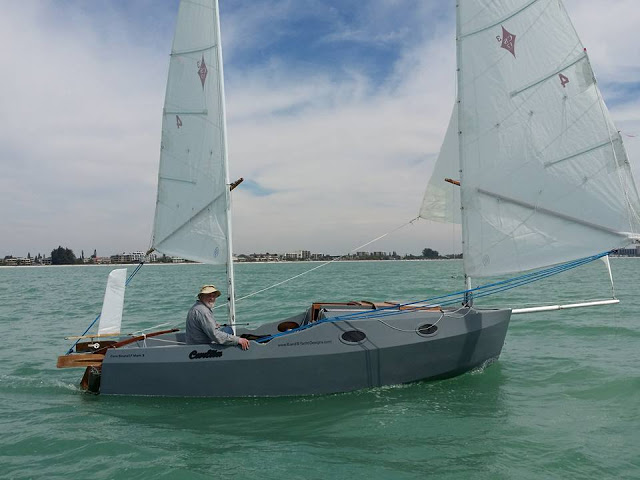
Above, Graham steering his then unpainted Core Sound 17 Mark 3 Carlita with all sails flying in the 2016 Everglades Challenge. Note that this earlier version of the kick up wind vane employed a vertically pivoting vane which was converted the more recent version afterward. Vertically pivoting vanes have less power but do offer some advantages such as being able to just point into the wind when not in use. (photo Patrick Johnson)
Graham continues...
"The key is an ultra light vane and very low friction. The lead counter weight is just 6 oz on Carlita's system. to balance the vane. This makes the vane very responsive and reduces friction and lowers the mass moment of inertia. The next important feature is differential feedback in the linkage. This means that when the vane kicks the servo tab over and the tab turns the auxiliary rudder, the angle of the tab is rapidly reduced. If you do not have this feature the boat will hunt badly down wind where there is no natural balance from the sails as you do when close hauled. The whole thing is a delicate balance between power and feedback."
In the video below, Graham sails Carlita a Core Sound 17 Mark 3 with the wind vane rudder disabled and in the "raised" position and the boat steers herself with proper sail trim to windward. Notice that the tiller is simply lashed.
"I want the rudder fixed to aid directional stability. Before engaging the vane, I try to find the sweet spot for the rudder and lock it. I will then observe the course after the vane is engaged for a while and I may rotate the vane or move the tiller slightly. Usually I adjust the vane first. It is a powerful little vane and will tolerate a fair amount of imbalance. All self steering systems hunt but the better everything is balanced the less oversteering there will be.
If you do not enjoy fiddling then a wind vane may not be for you. Naturally they are worthless in waterways because the wind is too shifty. But It did do a great job last week running down the Cape Fear River. The GPS showed a top speed of 8.75 knots and the speed was rarely under 6, at least 3 knots of that was current." -Graham Byrnes

wavefront marine
Tiller clutch (standard).

B&B Windvane Self Steering Plans
Yachting Monthly
- Digital edition

Windvane steering: why it makes sense for coastal cruising
- Will Bruton
- October 15, 2018
No electricity needed, built for gale-force conditions and currently experiencing something of a renaissance amongst cruisers; windvane self-steering makes sense for coastal cruisers as much as offshore voyagers. Will Bruton took an in depth look at the options and how they work.
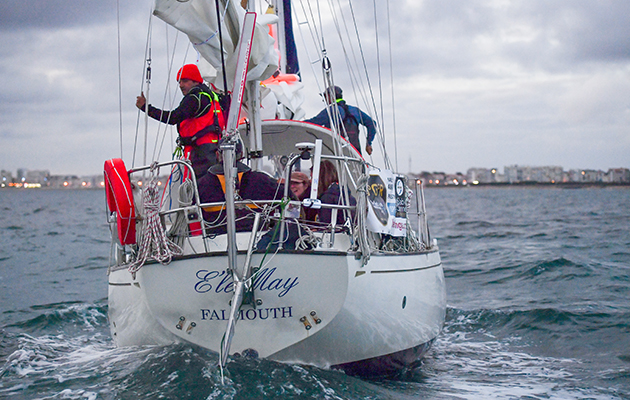
‘The distance run was 2,700 miles as the crow flies. During those 23 days I had not spent more than three hours at the helm. I just lashed the helm and let her go; whether the wind was abeam or dead aft, it was all the same: she always stayed on her course,’ wrote Joshua Slocum in 1895.
The ability of his long-keeled Spray to hold course without input from the helm was instrumental in making her the first yacht to circumnavigate single-handed.
Few modern boats bear these inherently balanced characteristics, so some form of autopilot is necessary to allow the skipper to rest.
Even for crewed passages, it can take an enormous strain off the crew without draining the battery. Some insurance companies even count windvane steering as an additional crew member, such is its contribution to life on board.

Unlike an electronic autopilot, self-steering needs no power
One solution experiencing something of a renaissance, is windvane self-steering.
Requiring no electricity, mechanical self-steering gear was first designed in an age when autopilots were the preserve of large ships and heavy motor cruisers. The principle is relatively simple and pure physics.
What mechanical self-steering cannot do is hold your yacht on a compass course. However, as anyone that’s experienced a sudden wind shift or squall whilst away from the helm knows, steering to a wind angle is preferable most of the time as you are far less likely to crash gybe, and the sails remain correctly set.
Self-steering gear achieves this by presenting a vane directly into the wind. When the wind acts on either side of this vane, it tips, transferring this action through the mechanism below to either a rudder or a servo pendulum which acts on the main rudder, altering the boat’s course.
The two main systems
Servo-pendulum
A derivative of the servo-trim tab principle invented by Blondie Hasler, servo-pendulum self steering gear uses the speed of the yacht going through the water to push against the servo-paddle, creating a substantial force, which is then transferred to the yacht’s own tiller or wheel by control lines.
The wind itself does not provide the power for the steering; rather it adjusts the angle of the paddle, relying on the hydro-mechanical energy of the boat going through the water to do the work of steering the boat.
Popular before the advent of the small craft electronic autopilot, it’s particularly well suited to yachts under 40ft in length, and can be swung out of the water when not in use.
There are now several derivatives, including some available as a self-build kit. Amongst the Golden Globe Race entrants, models included Aries, Monitor, Windpilot and Beaufort systems.
One disadvantage of the servo-pendulum gear is that it uses the yacht’s rudder, meaning it does not double up as an emergency rudder should the yacht’s steering be disabled, although some servo-pendulums can be adapted.
Direct drive systems
Wind vane steering linked to a secondary rudder is the most inherently simple of the mechanical self-steering systems, but relies on a much more powerful transmission of force between a large-surface-area wind vane and the system’s own independent rudder.

Direct drive systems feature a large fully independent auxiliary rudder
This has the advantage of ensuring a back up steering method is already on board but also requires a heavy-duty installation to bear the load and strain that will be exerted.
One of the most popular models is the Hydrovane, which is now available in several different sizes and shapes depending on the boat it is being installed on.
The size and shape of the fabric-covered windvane is directly proportional to the size of yacht, and has been installed successfully on yachts in excess of 50ft in length, including multihulls.
When the boat veers off course, the wind hits the vane on one side or the other, deflecting it away from the vertical.
This then acts on a gear that converts this sideways movement into rotation to directly steer a relatively large rudder suspended from the boat’s transom via the installation framework.
Setting up windvane steering
Balancing the boat.
‘Before doing anything, you have to get the boat sailing well. It demands you take the time to get your boat properly balanced, correctly reefed and with no weather helms; so it actually makes you a better sailor!’ explains Nick Nottingham, who recently fitted a Hydrovane to his Hallberg-Rassy 42, Spellbinder . Nick is about to use the system on an Atlantic circuit.

Self-steering relies on a well balanced boat. As the wind shifts, the mechanism corrects
Self-steering gear works by adjusting the yacht’s course in relation to the apparent wind. The first step to making this work as efficiently as possible is to balance the boat and reduce the amount of input required.
Sailing conventionally, the yacht should be easy on the helm and not overpowered.
Setting the system for the conditions
Whether servo-pendulum or direct drive, most self-steering systems have one or more methods of adjustment for the conditions. In light airs, the wind vane will be exposed as much as possible to the wind, to exert the maximum force on the system, whereas in heavier weather, the vane’s height can be lowered, reducing the force acting on the system.
Some systems, like the Hydrovane, Monitor and Beaufort have different sized vanes that can be swapped, while the Windpilot and Aries allow the vane to be raked aft, presenting a shorter level.

With the wind vane attached, you are ready to remove the locking pin and engage the steering mechanism
On some set ups, the power exerted on the steering system can also be adjusted at the point where the wind vane meets its pivot, just like changing sensitivity on an electronic autopilot. By controlling the rotation of the rudder or paddle created by the windvane, you control how aggressively the system corrects the boat’s course.
Changing the gearing at the point where the wind input creates the steering output achieve an increase or decrease of ratio.
Engaging the system
To engage the system, set the yacht on course and adjust the wind vane so that the wind is flowing over it with the least resistance, like a blade.
If you a using a system with its own rudder, centralise and lock the yacht’s main rudder, simultaneously engaging the self-steering mechanism.

Once engaged, monitor how the system adjusts and double check your sails are trimmed correctly.
As the vane moves it will adjust the steering accordingly.
In heavy weather, reduce the system’s power to ensure the least amount of strain.
Self-steering systems work efficiently in strong winds but most will steer comfortably in light airs as well.
Course adjustments
When the wind vane is vertical, you are on course. When the vane is deflected, the system is adjusting course.
Changing the direction you want to go in is simply a matter of altering the self-steering system’s vane angle relative to the wind.

On most systems this is achieved by a steering line that can be run into the safety of the cockpit, meaning you do not necessarily need to adjust the vane itself directly.
Make small adjustments until the yacht comes onto the desired course, trimming the sails appropriately.
A standalone system?
Whilst self-steering systems offer a much more resilient option than an electronic autopilot for heavy weather, when there is no sailing wind, they cease to be useful.

Here an electronic tillerpilot has been plugged directly into the Hydrovane auxiliary rudder
For this reason, most cruisers also have a conventional electronic autopilot on board to steer under engine.
In the case of systems incorporating a rudder, many also make it possible to easily engage a tiller pilot onto the system’s auxiliary rudder for use under engine.
Self-steering on the Golden Globe Race
If there’s one place that mechanical self-steering fandom bordered on the evangelical this year, it was at the start of the Golden Globe Race .
50 years previously, Robin Knox-Johnston’s world first single-handed circumnavigation was steered by his own self-steering gear system until it failed near Australia.
Restored to her former glory, Knox-Johnston’s Suhaili joined the parade; along with Indian competitor Abhilash Tommy’s replica yacht Thuriya , which sports a commercially made Windpilot servo-pendulum system.

Self-steering gear on Suhaili. Credit: Nic Compton/Alamy Stock Photo
With this year’s revival competition using 1960’s technology and electronic wizardry strictly prohibited, mechanical self-steering systems are effectively the only option for competitors. Each has chosen carefully.
Competitors in the race are using a variety of systems including Hydrovane, Aries, Monitor, Windpilot and Beaufort.
Due to the nature of the boats competing being long keeled, they are ideally suited to mechanical self-steering, naturally holding course better than a modern hull. However, should systems fail and prove unrepairable, it will be hard for them to remain competitive in the race.
Enjoyed reading this?
A subscription to Yachting Monthly magazine costs around 40% less than the cover price .
Print and digital editions are available through Magazines Direct – where you can also find the latest deals .
YM is packed with information to help you get the most from your time on the water.
- Take your seamanship to the next level with tips, advice and skills from our experts
- Impartial in-depth reviews of the latest yachts and equipment
- Cruising guides to help you reach those dream destinations
Follow us on Facebook , Twitter and Instagram.

IMAGES
VIDEO